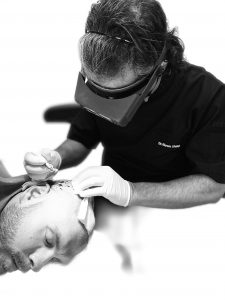Hair Transplant
 Hair Transplant Techniques and Applications
Hair Transplant Techniques and Applications
Hair transplantation is a complex aesthetic surgery application performed by doctors together with nurses’ assistants. So much so that it requires separate experience and knowledge for each of them, from determining the suitable candidate for hair transplantation, to anesthesia, removing the roots, opening holes where the hair follicles will be placed and placing the roots.
Almost completely natural results can be obtained with hair transplantation. The result can be determined by evaluating your age, donor frequency, open area and hair structure. Thus, you can decide whether you are suitable for hair transplantation or not.
Assessment can be done technically both by examination and various assistance with the help of digital instruments.
Is hair transplantation a painful procedure, one of the most asked questions? Hair transplantation is an almost painless procedure performed under local anesthesia. Local anesthesia should be applied with the appropriate injection technique.
In summary, when the result of the hair transplantation procedure is calculated mathematically, it can be predicted what kind of result can be reached. The ratio between the open area and the area to be covered determines the outcome of the process.
However, experienced and expert physicians can improve the result by adding their skills to this mathematical ratio.
In which situations can hair transplant be done?
- Genetic Male pattern hair loss (Androgenetic Alopecia)
- Female pattern hair loss (Female Androgenetic alopecia, Female pattern hair loss)
- Hair loss due to reasons such as accidents and burns
- Permanent hair loss caused by skin diseases (Lichen pilanopilaris, FFA, DLE…)
- Female patients who start from the back of the hairline and want to be brought forward or who have a male pattern hairline.
- Beard transplant
- Mustache transplant
- Eyebrow transplant
Hair transplantation is still the only alternative method for recovering lost hair in irreversible hair diseases.
Below, you will find general hair transplantation information prepared at a more academic level.
Modern hair surgery Follicular unit transplantation (fut) can be obtained almost completely natural results by taking hair follicles from the resistant hairy area and transplanting them to the balding area. Thanks to the Follicular unit extraction, which has become popular in the last decade, the indication areas have expanded due to the absence of linear scar in the donor area, allowing it to be used as a donor in other body areas.
Hair is one of the most important components of self-image and identity, and individuals who encounter hair loss think that deterioration of their image may be a social disadvantage for them. There are publications showing that the quality of life of individuals with hair loss decreases, depression, lack of self-confidence and less social integration. That is why patients with hair loss should be treated in order to minimize these effects.
Currently, the only permanent method in the treatment of alopecia is hair transplantation. Hair transplantation is among the most important aesthetic treatment alternatives not only for patients with genetic hair loss but also for cicatricial alopecia, eyebrows, beard, mustache, pubic area and eyelashes.
With the modern techniques developed in hair transplantation and the natural and satisfactory results obtained, more patients have become suitable candidates for hair transplantation.
What are the differences between FUE hair transplantation treatment and FUT hair transplantation treatment?
| FUE Hair Transplant | FUT Hair Transplant |
|---|---|
| Point scars (in proportion to the number of grafts) | Linear straight line scar |
| Limited number of grafts | Number of grafts depends on strip width |
|
Decreased efficiency of the second session due to fibrosis and dilution. |
Second session that can be planned depending on scalp tension |
|
Cutting the hair short before the procedure. |
|
|
High cost per graft |
Lower cost per graft |
|
Body hair can be used |
Body hair cannot be used |
|
Faster recovery after the procedure |
Stitches need to be removed after the procedure |
Hair transplant indications and determination of the suitable candidate
One of the most important stages of hair transplantation is determining the right candidate. Successful cosmetic results in all cosmetic procedures begin with determining whether the candidate is suitable or not. One of the most important criteria when determining the suitable candidate for hair transplantation is the availability of donors to meet the expectations of the patient. Patients with insufficient donors will not be suitable candidates for the procedure from the outset.
For which indications can hair transplantation be performed?
- Androgenetic alopecia (AGA)
- Female patients with female pattern androgenetic alopecia (FAGA)
- Cicatricial alopecia
- Secondary cicatricial alopecia
- Primary cicatricial alopecia
- Facial hair transplantation: Beard, mustache transplantation, eyebrow and eyelash transplantation
- Pubic hair transplantation
Conditions to be considered in determining the suitable candidate
The age of the patient; Timing is one of the important factors in hair transplantation. Unlike other medical indications, there is no advantage of early hair transplantation. Most of the young people who encounter hair loss in their 20s want to regain their old hair lines. Hair transplantation is generally not recommended before the age of 25 in terms of both the difficulty in estimating the stage at which hair loss will end and the patient’s expectation.
Relative contraindications for hair transplantation; Patients with bleeding disorders, those who use blood thinners, those with unstable arrhythmia problems, those with chronic obstructive pulmonary disease and major psychiatric disorders. One of the most difficult issues in hair transplant consultation is to evaluate the patient’s expectation. Understanding patients who do not have realistic expectations is the most important experiential part of the consultation. Patients who do not have realistic expectations should not be accepted for the procedure.
FUE Method
It is the process of removing FUs one by one from the scalp without the need for a subsequent separation process. FUs hold tightly to the scalp and subcutaneous tissue with the arrector muscle. The grafts are freed with punch cuts of 3-4 mm depth made at this level and then collected with adipose tissue with the help of forceps. The experience of the doctor and the skin structure of the patient are the factors that affect the transection rates of grfats. The punches used for extraction vary in diameter 0.6-1.0 mm depending on the patient’s hair thickness. Punches can be used as sharp or blunt punches. Recently, it has been observed that the transection rates have decreased in new punches in the form of stars and trumpets.
Evaluation and planning
- Photo; The photograph of the patient should definitely be taken in order to evaluate and record the result before and after the procedure.
- General evaluation; Laboratory tests are generally not needed for the diagnosis of AGA in male patients. However, detailed examinations may be needed to diagnose telogen effluvium and some other causes of hair loss in female patients. In addition, the patient’s whole blood, metobalic status, hepatitis panel and HIV tests should be requested before the procedure. In fact, the first evaluation that is more important than all these may be the psychological state of the patient. In patients with trichotillomania, body dysmorphic syndrome, and obsessive-compulsive disorder, the procedure may not be as desired. Hair transplantation may be contraindicated for patients with trichothiolomania and body dysmorphic syndrome.
- Evaluation of the recipient area; Norwood classification is used for male patients and Ludwig classification is generally used for female patients in the evaluation of the recipient region. In the light of these classifications, the estimated number of grafts needed for patients is determined. The average number of grafts in male patients according to the stages of hair loss is given in the table below.
- Evaluation of the donor; While evaluating the donor, the follicular unit density per cm2 should be evaluated in terms of the hair density in cm2, the color of the hair, the thickness of the hair and the shape of the hair.
- Donor follicular unit density and hair density are the most important factors in determining suitable candidates for hair transplantation. Patients with 225 hairs / cm2 are lucky candidates for hair transplantation. Patients with a density of 150-180 hair / cm2 should be evaluated specially, patients with a hair density of less than 150 hair / cm2 may not be suitable candidates for hair transplantation according to their conditions. Hair with a hair thickness of less than 60 microns usually obtain less volume. Patients with a hair diameter greater than 80 microns are highly advantageous. If the frequency of donors is not good in these patients, the desired volume will not be obtained as a result of the procedure. Hair character also affects hair transplantation. Patients with wavy and curly hair and light colored hair will produce more advantageous results.
- Determination of the hairline; It should be planned in accordance with the patient’s face. However, in cases where the number of grafts is insufficient, it can start a little higher. The height of the hairline is generally 8-9 cm above the eyebrow line connecting both eyebrows.
Pre-procedure warnings and consent; Before the procedure, all the drugs used by the patients should be reviewed and the drugs that may interact during the operation and the drugs that may cause bleeding problems should be discontinued. Providing information for the method to be made and discussing the differences between the methods. The possibilities of anesthesia, drug allergy, infection, folliculitis, cyst formation, scarring in the donor and recipient area, numbness and numbness should be explained beforehand and their consent should be obtained. - Hair transplantation process; Hair transplantation involves the transfer of hair from the donor area to open areas.
- Anesthesia; Hair transplantation is a procedure that can be performed under local anesthesia. However, the procedure can be performed effectively thanks to an effective anesthesia that continues throughout the operation.
- Getting hair follicles with FUT method
Hair transplant in women
Although hair loss in men causes a loss of self-confidence, it can be seen as a sign of maturity and wisdom by the society to some extent, but it is not accepted in terms of cultural and sexual attraction in women. Hair loss in women is thinning and thinning rather than baldness. In addition, women have more options than men to hide their hair loss.
Indications for hair transplantation in women
- Female pattern hair loss (Female pattern Androgenetic alopecia)
- Scarred alopecia
- Tractional alopecia
- Regeneration of the hair avalanche due to the back or recession of the hairline
Unlike men, women can easily publicize as they usually preserve the hairline and appear as a thinning in the rest. It only becomes visible in the advanced stages of hair loss. The most important problem in female patients is whether enough donor frequency is sufficient. For this reason, it is necessary to first look at the frequency of donors and the hair density in each folllcular unit in determining the suitable candidates.
When choosing a hair transplant method in women, the patient should be asked about shaving the donor area. Patients who do not want to shave, usually women, most patients do not want to shave. FUT method can be chosen for these patients. Since the strip part removed from the donor area will only be shaved, there is no difficulty after the procedure. With this method, the FUE method is used for patients who have reservations about the scar due to the remaining suture scar.

 Hair Transplant Techniques and Applications
Hair Transplant Techniques and Applications